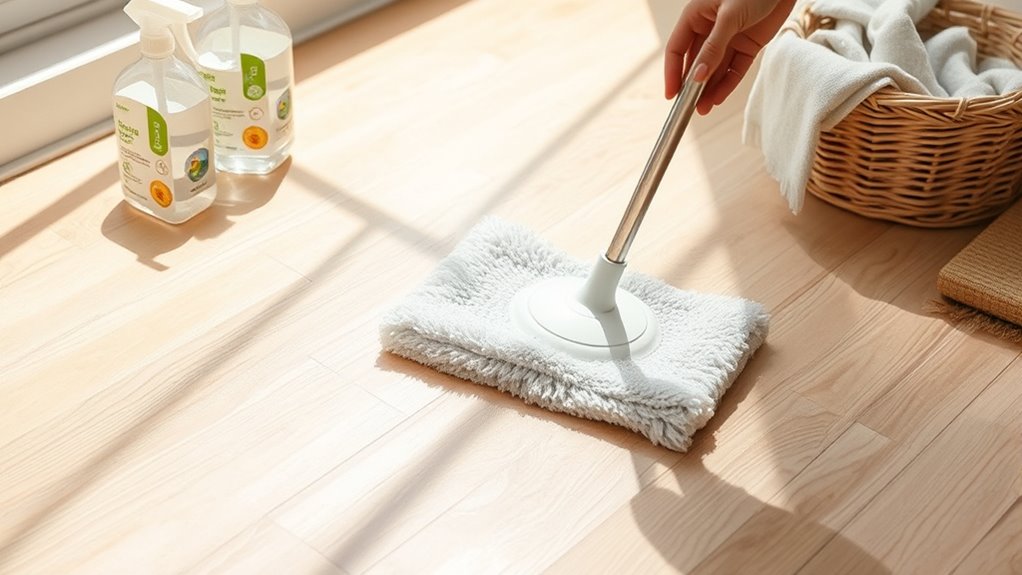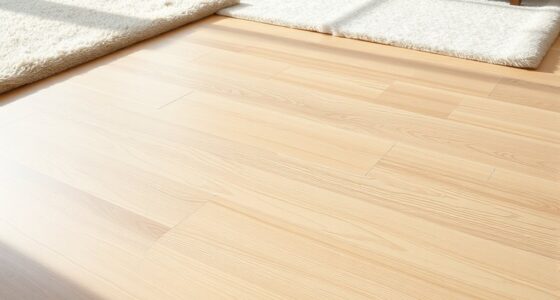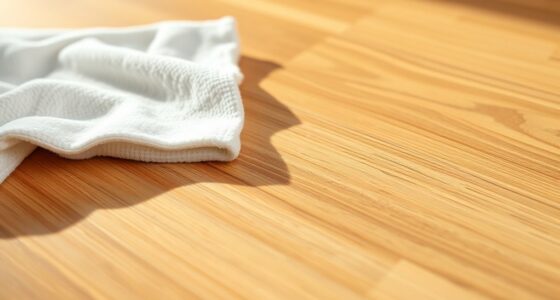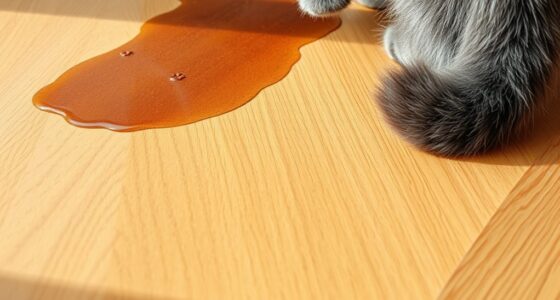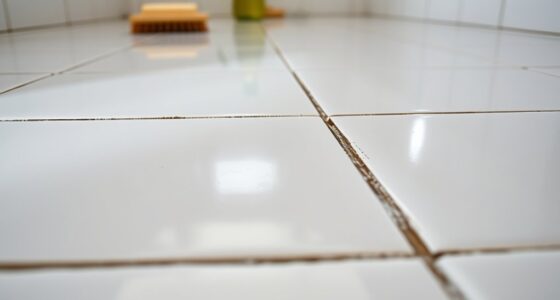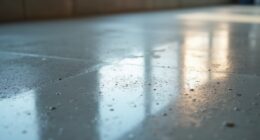To disinfect laminate floors safely, use gentle, pH-neutral disinfectants designed for delicate surfaces, like diluted rubbing alcohol or commercial laminate floor cleaners. Avoid harsh chemicals such as bleach, ammonia, or abrasive cleaners, which can damage the surface. Be sure to use a damp cloth and dry thoroughly afterward to prevent moisture damage. Proper techniques help preserve your floor’s appearance and longevity—continue to discover how to maintain your floors effectively long term.
Key Takeaways
- Use pH-neutral disinfectants labeled safe for laminate floors, such as diluted rubbing alcohol or commercial laminate-safe cleaners.
- Avoid harsh chemicals like bleach, ammonia, or abrasive scrub brushes that can damage the surface.
- Ensure disinfectants are applied with a damp cloth or mop, not excessive liquid, to prevent moisture damage.
- Always dry the floor thoroughly after disinfecting to avoid warping or swelling.
- Test new disinfectant solutions on a small, inconspicuous area before full cleaning to prevent surface damage.
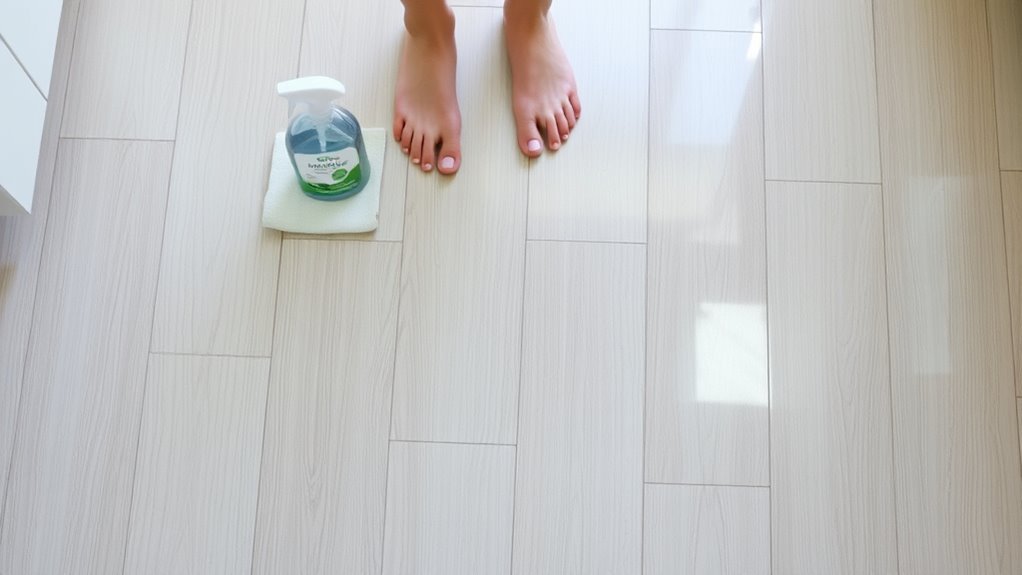
Are you wondering how to effectively disinfect your laminate floors without causing damage? The key lies in understanding the right cleaning frequency and how to protect the surface while disinfecting. Laminate floors are durable but can be sensitive to excessive moisture and harsh chemicals, so you need a careful approach. Regular cleaning helps maintain hygiene, but overdoing it or using the wrong products could compromise the surface protection. Typically, sweeping or dry mopping daily removes dirt and debris that can cause scratches. For routine cleaning, a damp mop with a gentle cleaner is sufficient. Disinfecting should be done periodically, depending on foot traffic and household needs, but not so often that it risks damaging the floor. Usually, once a week or biweekly disinfecting is enough for most homes. Remember, the goal is to keep your floors clean without overexposing them to moisture or chemicals that could cause warping or dullness over time.
When it comes to surface protection, always choose cleaning methods and disinfectants that are safe for laminate. Avoid using abrasive scrub brushes or harsh chemicals like bleach or ammonia, which can strip away the protective layer of your flooring. Instead, opt for mild, pH-neutral disinfectants that are labeled safe for laminate surfaces. You can also make a simple disinfectant at home by mixing a small amount of rubbing alcohol with water—just ensure it’s diluted properly to prevent any surface damage. Using too much liquid during cleaning can seep into seams and cause swelling or warping, so always use a damp cloth or mop rather than soaking the floor. After disinfecting, it’s a good idea to dry the surface thoroughly to prevent water damage and maintain its shine. Additionally, choosing a high-quality floor cleaner designed for laminate surfaces can help preserve the protective coating and prevent dullness over time.
Maintaining a consistent cleaning frequency combined with proper surface protection extends the life of your laminate floors. This disciplined approach prevents buildup of dirt and germs while preserving the integrity of the surface. Always follow manufacturer guidelines for cleaning and disinfecting products, and test new solutions on a small, inconspicuous area first. By doing so, you’ll avoid unexpected damage and keep your floors looking their best. Remember, the right balance of cleaning frequency and surface protection allows you to disinfect effectively without risking your floor’s durability or appearance. Keep this in mind every time you clean, and you’ll enjoy a safe, hygienic, and beautiful laminate surface for years to come.
Frequently Asked Questions
Can I Use Vinegar to Disinfect Laminate Floors?
You can use vinegar for DIY cleaning, but it’s not recommended for disinfecting laminate floors. Vinegar is a natural cleaner, yet it doesn’t effectively kill germs like chemical disinfectants do. For thorough disinfection, opt for products specifically designed for laminate surfaces or approved disinfectants. Avoid using harsh chemicals or undiluted vinegar, as they can damage the laminate’s finish over time. Always follow manufacturer guidelines for safe, effective cleaning.
How Often Should I Disinfect Laminate Flooring?
Think of your laminate flooring as a garden that needs regular tending. You should disinfect your floors once a week to maintain a healthy, sparkling surface. Use gentle disinfectant types like diluted alcohol solutions or specially formulated floor cleaners, avoiding harsh chemicals like bleach. Regular flooring maintenance prevents buildup of germs and grime, keeping your home fresh and safe. Consistent care guarantees your floors stay beautiful and resilient over time.
Are Steam Cleaners Safe for Laminate Surfaces?
Steam cleaning is generally safe for laminate surfaces if you use it correctly, but avoid excessive heat and moisture that can cause damage. It’s best to steer clear of chemical disinfectants with harsh chemicals, as they may harm the finish. Instead, opt for a damp mop or cloth with water or a gentle cleaning solution. Always follow the manufacturer’s instructions to prevent warping or delamination of your laminate flooring.
What Natural Disinfectants Are Effective for Laminate Floors?
Did you know that over 60% of people prefer eco-friendly cleaning options? For laminate floors, natural disinfectants like vinegar diluted with water or tea tree oil mixed with water are effective DIY disinfectants. These eco-friendly cleaning choices kill germs without harsh chemicals, keeping your floors safe. Just remember to use a damp mop and avoid excess moisture, ensuring your laminate stays protected while you disinfect naturally.
How Do I Remove Stubborn Stains Without Damaging the Laminate?
To remove stubborn stains without damaging your laminate floors, start with gentle cleaning techniques. Use a soft cloth dampened with a mixture of water and a mild, natural cleaner like vinegar or baking soda. Gently scrub the stain, avoiding excessive moisture and abrasive tools. For tougher stains, apply a small amount of rubbing alcohol or a specialized laminate stain remover, then wipe it clean. Always test in an inconspicuous area first.
Conclusion
To keep your laminate floors safe and spotless, stick to gentle disinfectants and avoid harsh chemicals. Think of your floors like a delicate garden — using the right care guarantees they stay vibrant and healthy. I once used bleach on my floor, thinking it’d disinfect better, but it left a dull patch. Remember, gentle solutions nurture your floors, just like watering a garden helps flowers thrive. Choose wisely, and your floors will shine for years to come.
